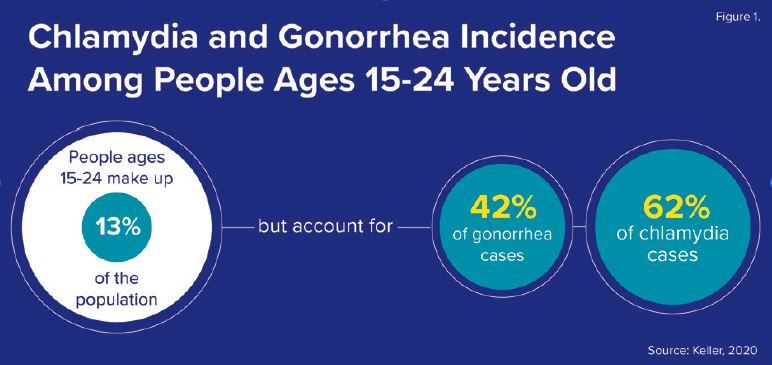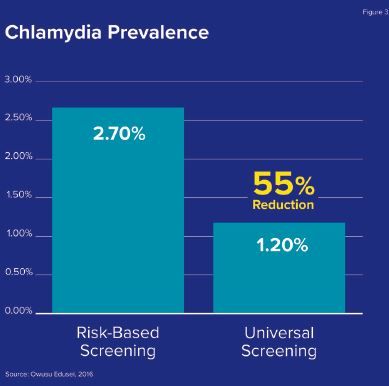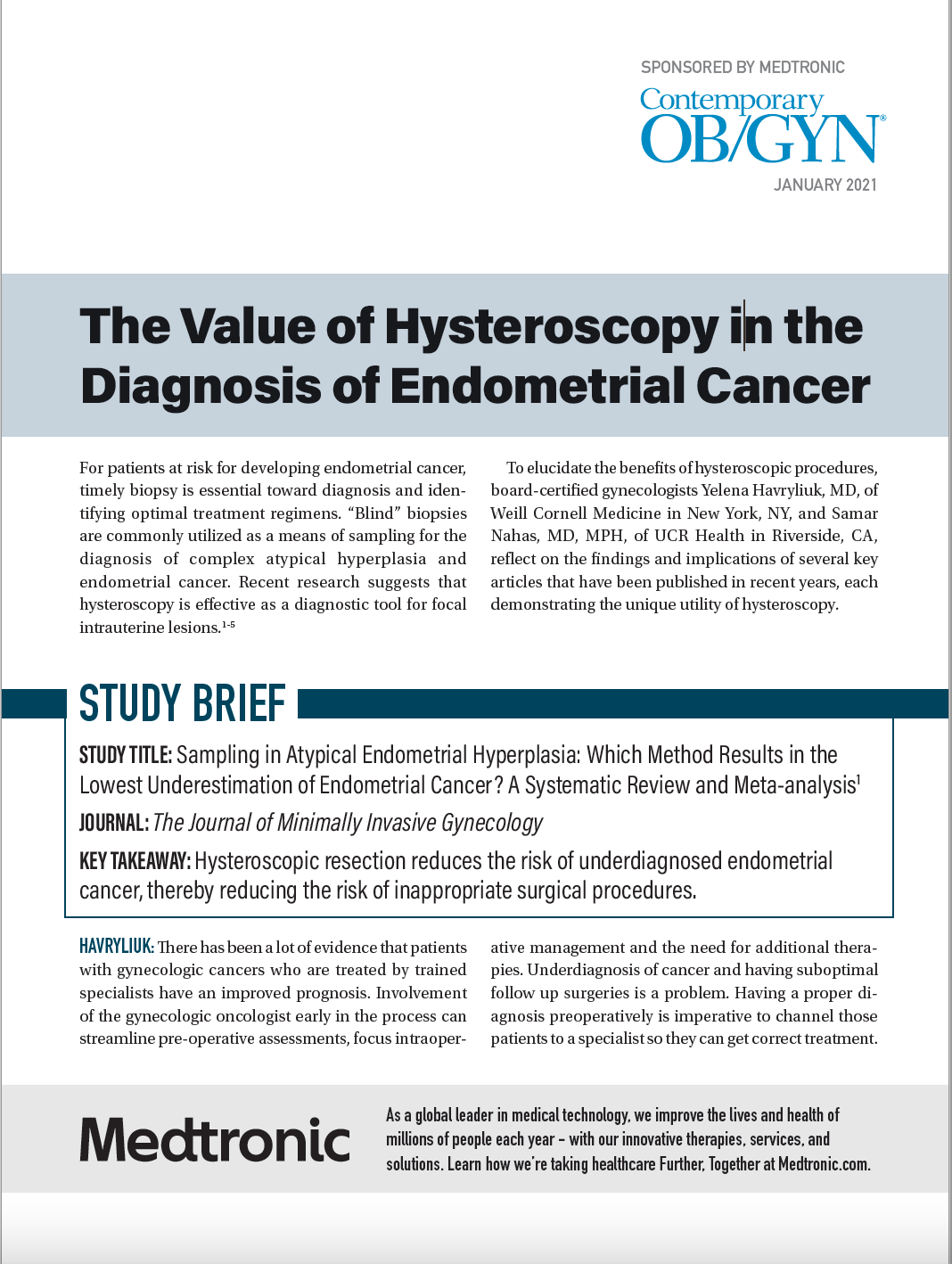Chlamydia Screening in the New Wave of COVID-19

Sponsored by: Hologic
Introduction
As the COVID-19 pandemic began shutting down communities around the United States (US), one unintentional consequence was the impact on nonCOVID related healthcare. Cancer treatments were delayed. Important elective surgeries were not performed. Wellness exams decreased. These delays, cancellations, and reduced hours along with limited testing have led to suboptimal healthcare, including preventative care, sexual healthcare, and screenings. But as we enter a new phase of the pandemic with the arrival of vaccines, we can start offering full access to healthcare services again. This is an opportunity to not only resume care, but also to enhance the healthcare services we deliver.
One area of improvement is routine screening for sexually transmitted infections (STIs). Recently, the Centers for Disease Control and Prevention (CDC) reported 26 million newly acquired sexual infections in 2018, with a $16 billion direct medical cost related to these STIs.1 The CDC reported one in five people in the US (20% of the US population) had an STI on any given day that year.2 Almost equally concerning is the continued burden and ongoing disproportionate effects of STIs on certain racial and ethnic groups as well as young people. Young people ages 15-24 years old account for almost 50% of all incident STIs, including Chlamydia trachomatis and Neisseria gonorrhoeae infections (Figure 1).2,3 This is further complicated by the fact that a large proportion of chlamydia infections are asymptomatic. One study even estimated that up to 84% of females with chlamydia have asymptomatic infections.4 Patients with asymptomatic infections often do not seek testing and are often not treated, which leads to increased transmission and increased potential complications; yet, screening rates for this infection remain low

The current rise in STIs and high rates of asymptomatic infections are concerning because undetected infections eft untreated can lead to long-term adverse health outcomes including pelvic inflammatory disease (PID), infertility, chronic pelvic pain, and an increased risk of HIV.5 As many as 30% of untreated chlamydia infections progress to PID,6 which contributes to the shocking statistic that 24,000 women become infertile each year due to undiagnosed STIs.7 The adverse health outcomes related to chlamydia combined with upward trends of infection highlight the need for providers to address this issue. Providers should be aware of national and local trends and incorporate routine screening to prevent development of sequela.
Chlamydia Screening Guidelines
Currently CDC, United States Preventive Services Task Force (USPSTF), the American College of Obstetricians and Gynecologists (ACOG), and the American Academy of Pediatrics recommend routine chlamydia and gonorrhea screening of all sexually active females <25 years of age. Screening of all sexually active women older than 24 years with high-risk behavior is also recommended.8 High risk behaviors include women who have a new sex partner, more than one sex partner, a sex partner with partners who are not the patient, a sex partner with an STI, inconsistent condom use, patients with a previous STI, and patients who exchange sex for money or drugs.9 CDC also recommends consideration of screening at any age for patients who live in high prevalence areas.
Barriers to Screening
Despite having guidelines that call for regular testing, the actual chlamydia screening rates leave much room for improvement. In 2019, reported chlamydia screening rates among sexually active women ages 16-24 years old ranged from only 47-58%.10 Given that a large percentage of infections are asymptomatic, this low screening rate is unacceptable. Factors that contribute to this low rate include patient discomfort with disclosing accurate information about their sexual behavior. A study found that greater than 10% of young adult patients who denied sexual activity in the past 12 months tested positive for an STI (6% of these patients reported a negative lifetime history of sexual activity).11 Other factors contributing to low screening rates include patients’ concerns with lack of confidentiality, stigma associated with STI testing, and perceived lack of risk. These barriers can lead to missed testing opportunities.
Opt-Out Screening
Opt-out chlamydia screening is notifying the patient that testing will be performed unless the patient declines. Opt-out screening is a more effective strategy to identify disease and is cost saving when compared to risk-based screening. Risk-based screening requires frank

discussions between healthcare providers and patients about the patient’s sexual activity, and relies on the patient to accurately report risk behaviors in order to inform the clinician’s decision to screen. Opt-out screening can identify infections in patients who do not disclose sexual behavior. An opt-out screening strategy does not eliminate the patient-provider conversation about sexual health, but includes STI testing as part of standard routine care as a way to remove the barriers to screening and open up a conversation about sexual health. In fact, routinizing STI testing for all patients has been shown to increase patient testing acceptance and therefore increase screening rates.12 Opt-out screening should target all young women within the high-risk age group covered by USPSTF and CDC guidelines (15-24 years old), without relying on their reported sexual activity.13
How to Implement Opt-out Screening
There are three main discussion points in opt-out screening (Figure 2). First is normalizing chlamydia testing. Inform the patient that chlamydia testing is part of routine clinical services. For example: “We recommend routine chlamydia testing for all women your age as part of the standard screening in this clinic.” It is often important to use normalizing language, such as “We ask everyone at every visit.” Second, allow patients to decline testing: “While you are here we would like to test you, if it is ok with you?” or “If you are ok with it we can test you today.” And third, give patients information regarding chlamydia transmission and treatment. For example: “Untreated chlamydia can lead to pelvic infections or infertility. If its ok with you we can test you today.” Making the patient feel comfortable and using normalizing language will make both the patient and staff more comfortable and reduce stigma.
Chlamydia Infection: Increasing Prevalence and Costs, Changing Trends
The CDC has released the latest snapshot of US STI rates, and it is an alarming picture. In 2018, there were nearly 68 million sexual infections diagnosed in the US and almost half of these infections were among young persons ages 15-24 years old.14 Chlamydia, trichomoniasis, genital herpes, and human papillomavirus (HPV) account for 98% of all STIs.14 In 2018, new sexual infections cost about $16 billion in direct lifetime medical costs, with women accounting for 25% of that total cost.14 Chlamydia infections alone accounted for $691 million of that total.14 Chlamydia screening has been proven to not only decrease chlamydia prevalence in the community but also has been shown to be cost effective. Screening can detect cases prior to development of adverse health outcomes of untreated infection, including PID and fertility issues. While all screening methods decrease total number of sequalae and estimated costs, opt-out screening was found to be more effective and less costly when compared to risk-based screening (Figure 3).13

Chlamydia is the most common reportable disease in the US, with over 1.8 million cases reported in 2019.15 In a 4-year span (2015 to 2019), chlamydia prevalence has increased by nearly 20%. Females, Black/African American and brown people and people ages 15-24 years old continue account for the highest rates of chlamydia infections.15 However, chlamydia rates are increasing in all racial and ethnic groups and all ages.15 Analysis performed by Quest Diagnostics between 2010 and 2017 shows that chlamydia and gonorrhea rates in females ages 12-30 years old are on the rise overall, but especially in older age groups.16 They reviewed 17.8 million chlamydia and gonorrhea tests and found the greatest increase in chlamydia rates was in women ages 25-30 years old. This age group had a 50% increase in chlamydia rates.16 Healthcare providers cannot ignore this increasing chlamydia rate in women of all ages and screening strategies should be mindful of these changing age trends.
Another consideration is incorporating extragenital testing as part of the screening protocol. While there are no current recommendations for chlamydia pharyngeal or rectal site screening for women, studies have found high rates of extragenital infection in female patients without genitourinary symptoms. It has been demonstrated that 10-25% of rectal chlamydia infections would have been missed if only genital site testing was sent. Other studies suggest that women may not always disclose rectal intercourse as part of their sexual behavior.17 A study examining extragenital chlamydia screening found only 13% of patients with a positive rectal chlamydia test reported having anal sex without a condom and less than 9% reported having anal sex with their last sexual partner.18 In addition, given female genitourinary anatomy, the rectum could possibly become infected via spread from the cervix and vagina in a woman with cervical chlamydial infection. Whether a patient discloses rectal intercourse as part of their sexual behavior or not, protecting patients from the adverse outcomes of chlamydia means more than just testing the vagina. Providers are encouraged to inquire about exposure sites and screen all sites with or without exposures.
A National Call to Action
The Department of Health and Human Resources (HHS) recently published a national strategic plan for the US. Some goals of this plan include prevention of new STIs, decreasing adverse outcomes associated with STIs, and decreasing disparities related to STIs. This plan focuses on the four STIs with the highest morbidity and the greatest impact on health: gonorrhea, syphilis, HPV, and chlamydia.19 One goal of the plan is to increase annual chlamydia screening for sexually active women ages 16-24 years old from the current rate of 58.8% up to 76.5% by the year 2030.18 This goal can be achieved by breaking down the social stigma associated with STIs and reframing STI screening as a health and wellness issue. Destigmatizing screening will allow both patients and providers to become more comfortable with screening. Focusing on screening as part of a health and wellness visit will lead to greater acceptance of STI screening and prevention and open up the conversation around sexual health.19
Conclusion
More than half of Americans will have an STI in their lifetime,19 and social stigma remains a barrier to STI education and screening. Healthcare providers play a vital role in improving chlamydia screening rates through the strategies they choose to implement in their practices. Opt-out screening is an effective and cost-saving method that can remove barriers to screening and help normalize conversations, thus reducing the stigma many patients associate with getting tested for STIs. Ultimately, more effective screening strategies will identify more STIs and prevent more life-altering adverse outcomes that can result from untreated infections, leading to better overall patient care.
REFERENCES
1. Centers for Disease Control and Prevention. CDC estimates 1 in 5 people in the U.S. have a sexually transmitted infection. Accessed 05-11-2021 at https://www.cdc.gov/nchhstp/newsroom/2021/2018-STI-incidenceprevalence-estimates-press-release.html#:~:text=Of%20the%20 estimated%20%2416%20billion,%2C%20gonorrhea%2C%20and%20 syphilis%20combined.
2. Kreisel KM, Spicknall IH, Gargano JW, et al. Sexually Transmitted Infections Among US Women and Men: Prevalence and Incidence Estimates, 2018. Sexually Transmitted Diseases. 2021;48(4):208-214. doi:10.1097/olq.0000000000001355
3. Keller LH. Guttmacher Institute. Reducing STI Cases: Young People Deserve Better Sexual Health Information and Services. Accessed 05-19- 2021 at https://www.guttmacher.org/gpr/2020/04/reducing-sti-casesyoung-people-deserve-better-sexual-health-information-and-services#
4. Detels R, Green AM, Klausner JD, et al. The incidence and correlates of symptomatic and asymptomatic Chlamydia trachomatis and Neisseria gonorrhoeae infections in selected populations in five countries. Sex Transm Dis. 2011;38(6):503-509. PMID:22256336
5. U.S. Department of Health and Human Services. 2020. Sexually Transmitted Infections National Strategic Plan for the United States: 2021–2025. Washington, DC. www.hhs.gov/STI.
6. Swain GR, McDonald RA, Pfister JR, Gradus MS, Sedmak GV, Singh A. Decision analysis: point-of-care Chlamydia testing vs. laboratory-based methods. Clin Med Res. 2004;2(1):29-35. doi:10.3121/cmr.2.1.29
7. Centers for Disease Control and Prevention. STIs among Young Americans 2013 Infographic. Accessed 05-11-2021 at https://www.cdc.gov/nchhstp/ newsroom/2013/sam-infographic-2013.html
8. Keegan MB, Diedrich JT, Peipert JF. Chlamydia trachomatis Infection: Screening and Management. J Clin Outcomes Manag. 2014;21(1):30-38.
9. Workowski KA, Bolan GA; Centers for Disease Control and Prevention. Sexually transmitted diseases treatment guidelines, 2015 [published correction appears in MMWR Recomm Rep. 2015 Aug 28;64(33):924]. MMWR Recomm Rep. 2015;64(RR-03):1-137.
10. National Committee for Quality Assurance (NCQA). Chlamydia Screening in Women (CHL). Accessed 05-011-2021 at https://www.ncqa.org/hedis/ measures/chlamydia-screening-in-women/
11. DiClemente RJ, Sales JM, Danner F, Crosby RA. Association between sexually transmitted diseases and young adults’ self-reported abstinence [published correction appears in Pediatrics. 2011 Apr;127(4):805]. Pediatrics. 2011;127(2):208-213. doi:10.1542/peds.2009-0892
12. Montoy JC, Dow WH, Kaplan BC. Patient choice in opt-in, active choice, and opt-out HIV screening: randomized clinical trial. BMJ. 2016; 352:h6895. doi.org/10.1136/bmj.h6895
13. Owusu-Edusei K Jr, Hoover KW, Gift TL. Cost-Effectiveness of Opt-Out Chlamydia Testing for High-Risk Young Women in the U.S. Am J Prev Med. 2016;51(2):216-224. doi:10.1016/j.amepre.2016.01.007
14. Centers for Disease Control and Prevention. At a Glance. Accessed 05-11- 2021 at https://www.cdc.gov/std/statistics/prevalence-2020-at-a-glance. htm
15. Centers for Disease Control and Prevention. Sexually Transmitted Disease Surveillance 2019. Atlanta: U.S. Department of Health and Human Services; 2021.
16. Kaufman HW, Gift TL, Kreisel K, Niles JK, Alagia DP. Chlamydia and Gonorrhea: Shifting Age-Based Positivity Among Young Females, 2010-2017. Am J Prev Med. 2020;59(5):697-703. doi:10.1016/j. amepre.2020.05.023
17. Llata E, Braxton J, Asbel L, et al. Rectal Chlamydia trachomatis and Neisseria gonorrhoeae Infections Among Women Reporting Anal Intercourse. Obstet Gynecol. 2018;132(3):692-697. doi:10.1097/ AOG.0000000000002804
18. Jann JT, Cunningham NJ, Assaf RD, Bolan RK. Evidence supporting the standardisation of extragenital gonorrhoea and chlamydia screenings for women [published online ahead of print, 2020 Dec 23]. Sex Transm Infect. 2020;sextrans-2020-054577. doi:10.1136/sextrans-2020-054577
19. U.S. Department of Health and Human Services. 2020. Sexually Transmitted Infections National Strategic Plan for the United States: 2021–2025. Washington, DC
AUTHOR BIOGRAPHY

Dr. Heather Territo is the Chief Medical Officer for the Erie County Health Department, Fellowship Director for the Pediatric Emergency Medicine Program at the University at Buffalo, and a Clinical Associate Professor of Pediatrics at the University of Buffalo. Dr. Territo serves as the Medical Director for the Erie County STD clinic and the Youth Detention center. Dr. Territo developed and implemented the County wide PrEP program and continues to serve as its director. She has authored several articles in peer review journals and has given local, regional and national presentations on STIs and PrEP. Her primary interest is education of physician trainees as well as other members of the healthcare community.

Dr. Gale Burstein is the Erie County Commissioner of Health and a Clinical Professor of Pediatrics at the University at Buffalo Jacobs School Medicine in Buffalo, NY and faculty at the New York City STD/ HIV Prevention Training Center. As a former CDC Medical Officer, Dr. Burstein worked on adolescent STI prevention programs, policy, and guidelines and directed the first national rapid HIV testing surveillance program. Dr. Burstein is currently leading Erie County’s public health COVID-19 response. In addition, Dr. Burstein is working on Erie County strategies to expand access to sexual health care, including PrEP and HPV vaccine. Dr. Burstein participates in writing national adolescent health care guidelines and has been published in many scientific peer review journals.
Click here to download the PDF


















